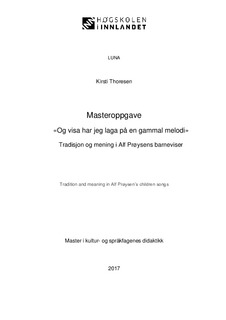| dc.contributor.author | Thoresen, Kirsti | |
| dc.date.accessioned | 2017-11-20T12:10:04Z | |
| dc.date.available | 2017-11-20T12:10:04Z | |
| dc.date.issued | 2017 | |
| dc.identifier.uri | http://hdl.handle.net/11250/2467132 | |
| dc.description | Mastergradsoppgave i kultur- og språkfagenes didaktikk, Avdeling for lærerutdanning og naturvitenskap, Høgskolen i Innlandet, 2017. | nb_NO |
| dc.description.abstract | Norsk:
Masteroppgaven er basert på et utvalg av Alf Prøysens barneviser med melodibakgrunn i tradisjonsmusikken. Alf Prøysen brukte, særlig i starten på sin karriere, melodier fra tradisjonsmusikken i sine hjemtrakter til sine viser både for barn og voksne. Tidligere forskning omkring Prøysens viser har i hovedsak dreid seg om det tekstlige grunnlaget for visene. Denne masteroppgaven tar for seg det melodiske grunnlaget for et utvalg barneviser.
Problemstillingen for masteroppgaven er «Hvordan anvender Alf Prøysen tradisjonsmusikk i sine barneviser, og hvilke konsekvenser får det for meningsdannelsen i disse visene?»
Det vitenskapsteoretiske grunnlaget for oppgaven utgjøres av en postkonstruktivistisk musikalsk hermeneutikk, der fortolkning av samspill mellom tekst og musikk; ulike intertekstuelle relasjoner; og utvalgte musikalske gester er de sentrale fortolkningsstrategiene.
Forskningen på Prøysens barneviser slik jeg gjør i denne oppgaven må betraktes som barnekulturforskning. Denne oppgaven forsker på kultur for barn (jfr. Mouritsen, 2002), der Prøysens rolle som en viktig medskaper av norsk musikalsk barnekultur er sentral.
For å skaffe utfyllende informasjon om melodigrunnlaget til Prøysen er det gjennomført to intervjusamtaler i arbeidet med oppgaven. Det er tidligere forsket lite på Prøysens bruk av tradisjonsmusikk i visene. Informantene, Olav Sæta og Thomas Nilssen er derfor brukt som faglige kilder i tillegg til tilgjengelig informasjon.
Oppgaven gir en meningsfortolkning av de utvalgte visene, og viser hvordan Prøysen ble påvirket av og brukte tradisjonsmusikken fra sin oppvekst på Hedmarken på en måte som gjør at han kan betraktes som en tradisjonsformidler innenfor sitt område. Ved å rette søkelyset mot musikkens rolle i Prøysens viser avdekker oppgaven en klar sammenheng mellom synsvinkelen i hans tekster, og i melodiene. Musikken han brukte, husmennenes musikk, forsterker den sosiokulturelle synsvinkelen i hans tekster, der han ofte løfter fram de lavere samfunnsklassene. Oppgaven ser på intertekstuelle relasjoner i visene gjennom begrepene palimpsest, adaptasjon og rewriting, og den ser på musikalske gester i Musevisa.
Kunnskapen som bringes fram i de ulike delene av fortolkningen har relevans for det musikkdidaktiske feltet, da den bringer fram ny forståelse av Alf Prøysens barneviser som lærestoff i undervisningen (jfr. Nielsen, 1997; 2002). | nb_NO |
| dc.description.abstract | English:
This master thesis is based on a selection of Alf Prøysen’s children’s songs (more specifically known as “barneviser” or just “viser” in Norwegian) with a melodic background in traditional music. Alf Prøysen used, particularly in the beginning of his career, melodies from traditional music in his home area, in his songs for both children and adults. Former research on Prøysen’s songs have mainly been about the textual basis of the songs. This master thesis deals with the melodic basis in a selection of children’s songs.
The thesis statement for this master thesis is “How does Alf Prøysen apply traditional music to his children’s songs, and what consequences does this have for the meaning-making, in these songs?”
The scientific basis for the thesis is constituted by a post-constructivist musical hermeneutics, where the interpretation of the interaction between lyrics and music; different intertextual relations; and selected musical gestures are the central interpretation strategies.
The research on Prøysen’s children’s songs, the way I do it in this thesis, should be considered as research in children’s culture. This thesis conducts research in culture for children (cf. Mouritsen, 2002), where Prøysen’s part as an important co-founder of Norwegian musical children’s culture is central.
To acquire complementary information about the melodic basis of Prøysen, it is conducted two interviews in the work of the thesis. There has previously been very little research on Prøysen’s use of traditional music in his songs. The informants, Olav Sæta and Thomas Nilsen is therefore used as professional sources in addition to available information.
The thesis gives an interpretation of meaning of the selected songs, and shows how Prøysen was both influenced by and used the traditional music from his adolescence in Hedmark in a way that makes him be considered as a conveyor of tradition within his area. By turning the spotlight on the music’s part in Prøysen’s songs, this thesis uncovers a clear connection between the point of view in his lyrics, and the melodies. The music he used, the crofter’s music, amplifies the sociocultural point of view in his lyrics, where he often brings out the lower classes in society. This thesis views intertextual relations in the songs through the terms palimpsest, adaption and rewriting, and it views the musical gestures in Musevia. The knowledge which is presented in the different parts of the interpretation is relevant to the field of music-didactics, because it presents a new understanding of Alf Prøysen’s children’s songs as material used in teaching (cf. Nielsen, 1997; 2002). | nb_NO |
| dc.language.iso | nob | nb_NO |
| dc.subject | MIKS | nb_NO |
| dc.subject | Prøysen | nb_NO |
| dc.subject | viser | nb_NO |
| dc.subject | visekultur | nb_NO |
| dc.subject | tradisjonsmusikk | nb_NO |
| dc.subject | barneviser | nb_NO |
| dc.title | «Og visa har jeg laga på en gammal melodi» Tradisjon og mening i Alf Prøysens barneviser. | nb_NO |
| dc.type | Master thesis | nb_NO |
| dc.subject.nsi | VDP::Humaniora: 000::Musikkvitenskap: 110 | nb_NO |
| dc.source.pagenumber | 82 | nb_NO |
